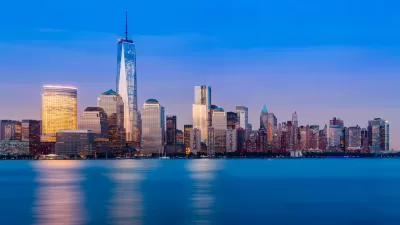Fear that skyscrapers might be a persistent target of terrorist attacks did not last long beyond the days and months following 9/11. Neither terrorists nor the Great Recession have stopped the city's skyline from continuing to reaching skyward.

"Shortly after the Twin Towers fell, there were predictions of the end of skyscrapers as a practical form of architecture. Others thought Ground Zero — hallowed ground — should not be rebuilt to such heights," according to an article by James M. O'Neill. "Yet, despite the searing emotional impact of the Sept. 11 attacks — and the economically stifling Great Recession of 2008 — the Manhattan skyline that Berman and other North Jersey residents know so well has been strikingly transformed."
"In the decade and a half since the Twin Towers fell, 15 of Manhattan’s 35 tallest skyscrapers have been built. And others will soon join them," adds O'Neill. To illustrate that point, and the scale of change that has come to the Manhattan skyline since 9/11, the article includes an interactive graphic.
For more reading on the growing heights of the New York skyline, but without the context provided by 9/11, the New York Times Magazine released a big, interactive issue documenting and illustrating the 21 buildings currently reaching above 800 feet in the city of New York.
FULL STORY: Since 9/11, New York City's skyline has only grown taller [interactive]

Planetizen Federal Action Tracker
A weekly monitor of how Trump’s orders and actions are impacting planners and planning in America.

Congressman Proposes Bill to Rename DC Metro “Trump Train”
The Make Autorail Great Again Act would withhold federal funding to the system until the Washington Metropolitan Area Transit Authority (WMATA), rebrands as the Washington Metropolitan Authority for Greater Access (WMAGA).

The Simple Legislative Tool Transforming Vacant Downtowns
In California, Michigan and Georgia, an easy win is bringing dollars — and delight — back to city centers.

The States Losing Rural Delivery Rooms at an Alarming Pace
In some states, as few as 9% of rural hospitals still deliver babies. As a result, rising pre-term births, no adequate pre-term care and "harrowing" close calls are a growing reality.

The Small South Asian Republic Going all in on EVs
Thanks to one simple policy change less than five years ago, 65% of new cars in this Himalayan country are now electric.

DC Backpedals on Bike Lane Protection, Swaps Barriers for Paint
Citing aesthetic concerns, the city is removing the concrete barriers and flexposts that once separated Arizona Avenue cyclists from motor vehicles.
Urban Design for Planners 1: Software Tools
This six-course series explores essential urban design concepts using open source software and equips planners with the tools they need to participate fully in the urban design process.
Planning for Universal Design
Learn the tools for implementing Universal Design in planning regulations.
Smith Gee Studio
City of Charlotte
City of Camden Redevelopment Agency
City of Astoria
Transportation Research & Education Center (TREC) at Portland State University
US High Speed Rail Association
City of Camden Redevelopment Agency
Municipality of Princeton (NJ)





























